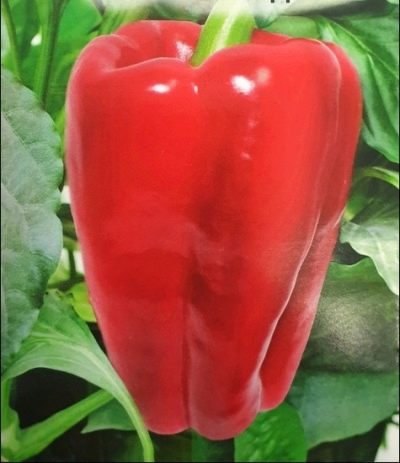
- Authors: Alekseev Yu.B.
- Year of approval: 2015
- Bush height, cm: up to 120
- Growth type: indeterminate
- Fruit shape: prismatic
- Fruit weight, g: 250
- Fruit color: in technical ripeness green to dark green, in biological ripeness red to dark red
- Ripening terms: mid-early
- Ripening month: July August
- Fruit size, cm: length 14-16, diameter 8-10
Pepper An early miracle has existed for more than 5 years, during which time it managed to earn the love of many gardeners. It is chosen for its endurance and ability to mature in different climatic conditions. In addition, you can count on a bountiful harvest with this variety.
Breeding history
The culture originated in our country thanks to the efforts of the breeder Alekseev Yu. B. In 2015, the Semko-Junior company officially entered it into the list of the State Register, and the variety became available for mass cultivation.
Description of the variety
An early miracle is a hybrid recommended for cultivation both in an open summer cottage and in a greenhouse.
Characteristics of the appearance of plants and fruits
The type of growth of this type of pepper is defined as indeterminate. The bush rises about 120 centimeters above the ground, and it is closed. According to their position, the fruits are directed towards the earth. The leaves are saturated green, of moderate size, slightly wrinkled. Vegetables ripen large, reach 14-16 centimeters in length, 8-10 centimeters in diameter.
In shape, the peppers repeat the prism. Each copy weighs about 250 grams. In the technical phase of maturity, the color of the vegetable ranges from pale green to dark green, in the biological phase - from scarlet to dark scarlet.
The peel is smooth, shines brightly in the sun. The walls of the fetus are powerful. Inside you can count 3-4 seed chambers. The consistency of the pepper pulp is dense.
Purpose and taste
The described variety is universal. Peppers can not only be eaten directly from the garden, cut into salads, soups and other dishes, but also canned and frozen. The taste qualities of the hybrid are praised, emphasizing that it is without bitterness.
Ripening terms
According to the characteristics of the species under consideration, it belongs to the mid-early category. The fruiting period starts 110-115 days after planting.
Yield
An early miracle pleases the owner with high productivity. On average, farmers remove 14 kilograms of vegetables from each square meter.
Growing regions
The geography of cultivation of this hybrid is extensive. It can be observed in the East Siberian, North-West, Central Black Earth, Far East, West Siberian, North, Middle Volga, Volgo-Vyatka, Nizhnevolzhsky, Central, Ural, North Caucasian regions of our country.
Landing scheme
When starting planting, a distance of 70 centimeters should be observed between the peppers. In addition, it is necessary to provide for a gap between the rows, it should be 50 centimeters.

To get a large and tasty harvest of pepper, you need to take care of the seedlings in advance. When growing pepper seedlings, you need to correctly determine the sowing time, pre-sowing seed treatment, prepare the necessary container and soil.
Growing and care
It is recommended to start sowing seeds in the March period.Before the emergence of seedlings, the planting material is kept under a film. Experts advise moving young plants to a permanent place in May, when the soil warms up to 15 degrees, and the air to 18-20 degrees. Each plant is tied to a trellis.
Immediately, it is advisable to mulch; for this, the bed is covered with a layer of sawdust, needles, ash, straw. Ash, in addition to retaining moisture, helps prevent fungal diseases.
Watering should be carried out as needed and evenly, avoiding waterlogging or overdrying the earth.
An early miracle must be pampered regularly with top dressing. Its role can be played by ammonium nitrate, magnesium, potassium compounds, monophosphate.
To protect peppers from insect attacks, it is recommended to plant spicy herbs or flowers with a pronounced aroma around the garden.

To harvest a tasty and rich harvest of pepper, you need to comply with all the conditions of agricultural technology, and proper care begins with planting plants. Before planting pepper in open ground, it should be prepared. It is also important to take care of the seedlings and planting space in advance.



Soil requirements
The culture feels comfortable in loose, well-drained, fertile soils.

For good growth of pepper bushes and active fruiting, you need to regularly apply mineral and organic fertilizing to the soil. It is necessary not only to choose the right formulations, but also to use them at the right stage in the development of culture. The frequency of top dressing is always individual. It depends directly on the composition of the land on your site. The poorer the soil composition, the more often you will need to feed the pepper.
Required climatic conditions
When deciding on a place for a garden, it is advisable to give preference to an area generously illuminated by the sun.
Disease and pest resistance
An early miracle shows heroic resistance to ailments such as the bronzing virus and tobacco mosaic.

Pepper is one of the most common vegetables in home gardens. This culture is quite stable and unpretentious. However, under certain conditions, this plant can suffer from infections and harmful insects. Before treating peppers for diseases or pests, you need to find out the cause of the problem, otherwise the treatment may be ineffective.
Review overview
Experienced gardeners, along with novice summer residents, highly appreciate the above-described variety. They note the presentable appearance of the vegetable, the juiciness and decent taste, the absence of difficulties in care and a considerable amount of the harvest.





















































































